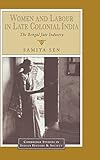Woman and labour in late colonial India : the Bengal jute industry
Material type: TextPublication details: New York; Cambridge university press; 1999Description: 265 pISBN:
TextPublication details: New York; Cambridge university press; 1999Description: 265 pISBN: - 9780521453639
- 331.4095414 SEN
| Item type | Current library | Call number | Status | Date due | Barcode | Item holds |
|---|---|---|---|---|---|---|
|
|
Gandhi Smriti Library | 331.4095414 SEN (Browse shelf(Opens below)) | Available | 153522 |
Browsing Gandhi Smriti Library shelves Close shelf browser (Hides shelf browser)
Samita Sen's history of labouring women in Calcutta in the late nineteenth and early twentieth centuries considers how social constructions of gender shaped their lives. Dr Sen demonstrates how - in contrast to the experience of their male counterparts - the long-term trends in the Indian economy devalued women's labour, establishing patterns of urban migration and changing gender equations within the family. She relates these trends to the spread of dowry, enforced widowhood and child marriage. The book provides insight into the lives of poor urban women who were often perceived as prostitutes or social pariahs. Even trade unions refused to address their problems and they remained on the margins of organized political protest. The study will make a signficant contribution to the understanding of the social and economic history of colonial India and to notions of gender construction.








There are no comments on this title.